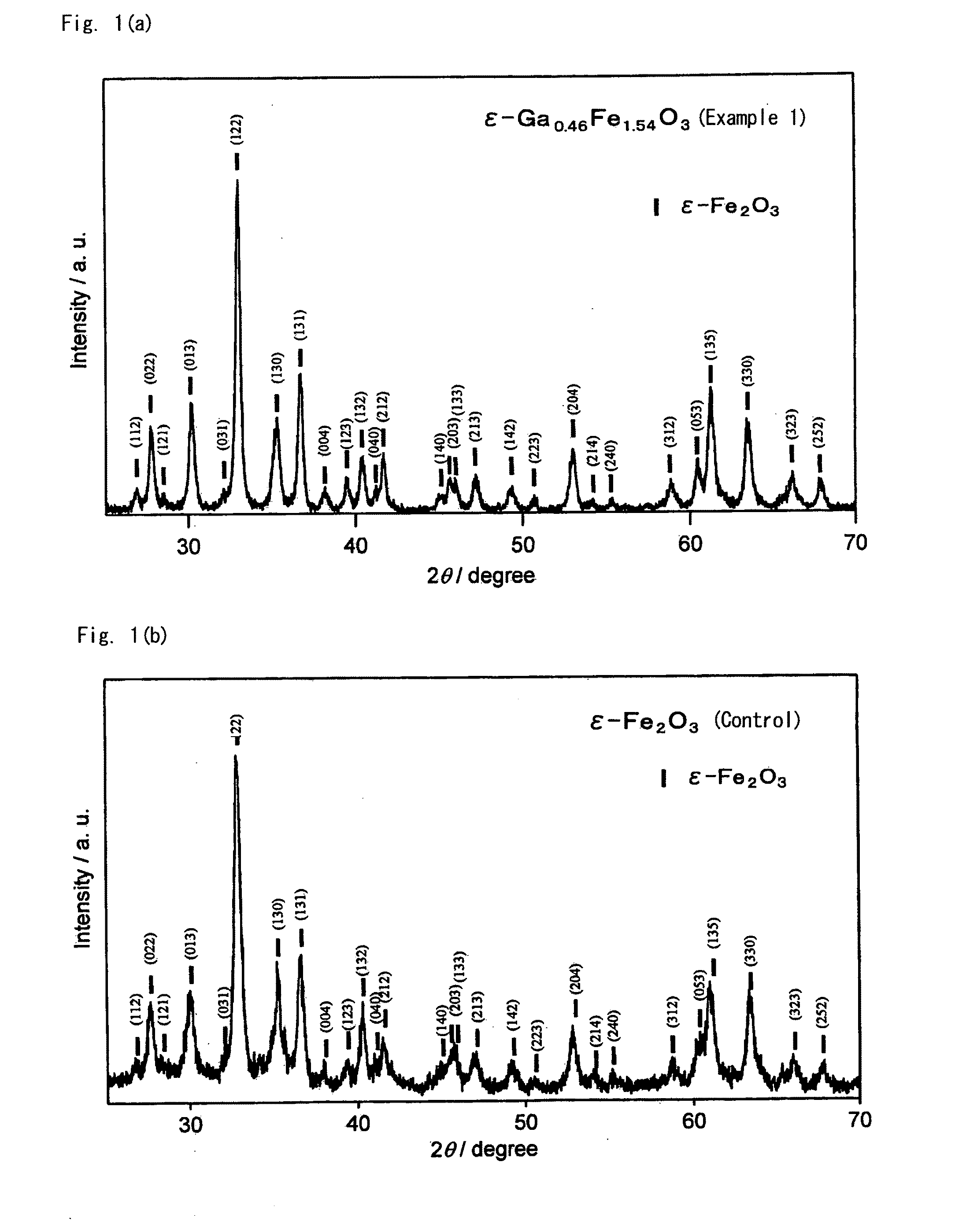Magnetic crystal for radio wave absorbing material and radio wave absorbent
- Summary
- Abstract
- Description
- Claims
- Application Information
AI Technical Summary
Benefits of technology
Problems solved by technology
Method used
Image
Examples
example 1
[0063]This Example is to demonstrate production of a crystal having a composition of ε-Ga0.46Fe1.54O3 using Ga as the substituent element M. This is according to the process mentioned below.
[Step 1]
[0064]Two types of micelle solutions, micelle solution I and micelle solution II are prepared.
Preparation of Micelle Solution I:
[0065]6 mL of pure water, 18.3 mL of n-octane and 3.7 mL of 1-butanol are put into a Teflon® flask. 0.002295 mol of iron(III) nitrate 9-hydrate and 0.000705 mol of gallium(III) nitrate n-hydrate are added thereto and dissolved with sufficiently stirring at room temperature. Further, a surfactant cetyltrimethylammonium bromide is added in an amount to give a molar ratio of pure water / surfactant of 30, and dissolved by stirring, thereby giving a micelle solution I. In this, gallium(III) nitrate n-hydrate is a reagent having a purity of 99.9% and n of from 7 to 9, produced by Wako Pure Chemical Industries; and before its use herein, the reagent was quantitatively an...
examples 2 to 6
[0080]Magnetic oxides of Ga-substituted ε-Fe2O3 crystal were produced in the same manner as in Example 1, for which, however, the feeding composition of the micelle solution I in the step 1 was changed as in Table 1; and they were analyzed for the characteristics thereof in the same manner as in Example 1. All these Ga-substituted ε-Fe2O3 crystals gave an X-ray diffraction pattern similar to FIG. 1(a). TEM pictures of these powders are shown in FIG. 3(b) to FIG. 3(f). The electromagnetic wave absorbing characteristics are shown in FIG. 2(a). Table 2 shows, as summarized therein, the analyzed composition and the properties of the magnetic oxides.
examples 7 to 9
[0081]Magnetic oxides of Ga-substituted ε-Fe2O3 crystal were produced in the same manner as in Example 1, for which, however, the feeding composition of the micelle solution I in the step 1 was changed as in Table 1. The obtained Ga-substituted ε-Fe2O3 crystals gave an X-ray diffraction pattern similar to FIG. 1(a). TEM pictures of the obtained particles are shown in FIG. 3(g) to FIG. 3(i).
[0082]The oxide powder was filled in a paper cylinder having a diameter of 40 mm and a height of 10 mm, thereby forming a packed structure, which was analyzed for the electromagnetic wave absorbing characteristics thereof within a range of from 96 to 140 GHz. Using a network analyzer of from 8 GHz to 11.8 GHz and a 12-power upconverter, the above-mentioned high-frequency test was realized. The transmitting and receiving antennas are horn antennas. The results are shown in FIG. 2(b). Table 2 shows the analyzed composition and the characteristics of the magnetic oxides.
TABLE 1Step 1Step 2Step 3Step ...
PUM
| Property | Measurement | Unit |
|---|---|---|
| Frequency | aaaaa | aaaaa |
| Frequency | aaaaa | aaaaa |
| Frequency | aaaaa | aaaaa |
Abstract
Description
Claims
Application Information
 Login to View More
Login to View More - R&D
- Intellectual Property
- Life Sciences
- Materials
- Tech Scout
- Unparalleled Data Quality
- Higher Quality Content
- 60% Fewer Hallucinations
Browse by: Latest US Patents, China's latest patents, Technical Efficacy Thesaurus, Application Domain, Technology Topic, Popular Technical Reports.
© 2025 PatSnap. All rights reserved.Legal|Privacy policy|Modern Slavery Act Transparency Statement|Sitemap|About US| Contact US: help@patsnap.com



